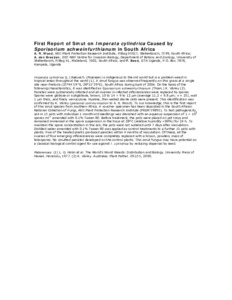| dc.contributor.author | Wood, A.R. |
| dc.contributor.author | Den Breeyen, A. |
| dc.contributor.author | Beed, Fen D. |
| dc.date.accessioned | 2019-12-04T11:11:51Z |
| dc.date.available | 2019-12-04T11:11:51Z |
| dc.date.issued | 2009 |
| dc.identifier.citation | Wood, A.R., Den Breeyen, A. & Beed, F. (2009). First report of smut on imperata cylindrica caused by sporisorium schweinfurthianum in South Africa. Plant Disease, 93(3), 322-322. |
| dc.identifier.issn | 0191-2917 |
| dc.identifier.uri | https://hdl.handle.net/20.500.12478/2508 |
| dc.description.abstract | Imperata cylindrica (L.) Raeusch. (Poaceae) is indigenous to the old world but is a problem weed in tropical areas throughout the world (1). A smut fungus was observed frequently on this grass at a single site near Pretoria (25°44′19′′S, 28°15′39′′E), South Africa during April of 2006. On the basis of the following characteristics, it was identified as Sporisorium schweinfurthianum (Thüm.) K. Vánky (2). Panicles were systemically infected and all ovaries in infected inflorescences were replaced by spores. Spores were globose or subglobose, brown, 10 to 14 × 9 to 12 μm (average 11.2 × 9.8 μm; n = 25), wall 1 μm thick, and finely verruculose. Hyaline, thin-walled sterile cells were present. This identification was confirmed by K. Vánky (personal communication to A. R. Wood). To our knowledge, this is the first report of this smut species from southern Africa. A voucher specimen has been deposited in the South African National Collection of Fungi, ARC-Plant Protection Research Institute (PREM 59895). To test pathogenicity, soil in 15 pots with individual 1-month-old seedlings was drenched with an aqueous suspension of 1 × 108spores ml–1 amended with 0.1% Tween 80. Before treatment, the pots were placed on pot trays and remained immersed in the spore suspension in the trays at 28°C (relative humidity <80%) for 24 h. To maintain the spore concentration in the soil, the pots were not watered until 7 days after inoculation. Distilled water amended with 0.1% Tween 80 was applied as control treatments to a further 15 pots with plants. Five of the treated plants produced panicles within 4 months of inoculation. Of these, all the ovaries of four emerging inflorescences were completely replaced with a brown, powdery mass of teliospores. No smutted panicles developed on the control plants. This smut fungus may have potential as a classical biological control agent for use against I. cylindrica by reducing dispersal by seed. |
| dc.format.extent | 322-322 |
| dc.language.iso | en |
| dc.subject | Spore |
| dc.subject | Inoculation |
| dc.subject | Fungus |
| dc.subject | Cylindrical |
| dc.subject | Smut |
| dc.subject | Inflorescences |
| dc.title | First report of smut on Imperata cylindrica caused by Sporisorium schweinfurthianum in South Africa |
| dc.type | Journal Article |
| dc.description.version | Peer Review |
| cg.contributor.affiliation | University of Stellenbosch |
| cg.contributor.affiliation | International Institute of Tropical Agriculture |
| cg.coverage.region | Africa |
| cg.coverage.region | Southern Africa |
| cg.coverage.region | East Africa |
| cg.coverage.country | South Africa |
| cg.coverage.country | Uganda |
| cg.isijournal | ISI Journal |
| cg.authorship.types | CGIAR and developing country institute |
| cg.iitasubject | Weeds |
| cg.iitasubject | Plant Production |
| cg.iitasubject | Plant Health |
| cg.iitasubject | Disease Control |
| cg.iitasubject | Plant Diseases |
| cg.iitasubject | Pests Of Plants |
| cg.howpublished | Formally Published |
| cg.accessibilitystatus | Limited Access |
| local.dspaceid | 93259 |

